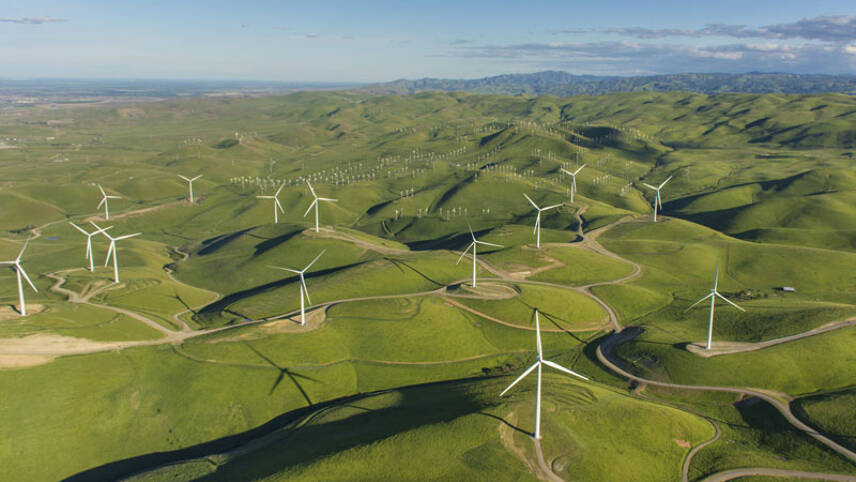Register for free and continue reading
Join our growing army of changemakers and get unlimited access to our premium content

Pictured: Golden Hills wind farm, CA, Google has a PPA to offtake electricity from the site. Image: Steve Proehl for FPL
Published on Monday (24 July), the report tracks progress towards Google’s sustainability targets for operations, covering carbon, water, resources and nature and biodiversity.
On carbon, Google has confirmed a 10% reduction in emissions across all scopes despite continued business growth. Scope 3 (indirect) emissions continue to account for the majority (75%) of its climate footprint. In comparison, operational (Scope 1) emissions account for just 1%.
The remaining 24% is attributable to Google’s use of power (Scope 2). The company has matched 100% of its electricity consumption with renewable energy purchases since 2017 and continued to do so in 2022, the report confirmed.
To drive down Scope 2 emissions further, and help other energy users do the same, Google is aiming to run on 24/7 carbon-free energy on every grid where it operates by 2030. This will ensure that local grids are benefitting from additional renewables capacity, while overcoming issues of transparency and credibility that can result from the purchase of clean electricity certificates.
The report reveals that, last year, the average Google facility matched 64% of its energy consumption with renewable power generated either on-site or on the local grid.
The proportion was highest in Finland – 97%. Also exceeding the 90% mark were Iowa, Denmark and Chile.
In contrast, it proved harder to procure energy in this way in Japan, Taiwan and Singapore, where the proportion was lower than one-fifth. Proportions under 30% were also recorded in Nevada and South Carolina.
The report states: “Achieving 24/7 carbon-free energy is far more complex and technically challenging than annually matching our energy use with renewable energy purchases. No company of our size has achieved 24/7 CFE before, and there’s no playbook for making it happen. But we see our efforts as part of a bigger picture, and we’ve set this ambitious goal to help scale new, global solutions.”
It notes that disruption to renewable energy supply chains and delays to grid connections for large projects proved to be particularly challenging last year. Grid delays for Google were worst in the Asia-Pacific region and the eastern US.
To help speed things along, Google has piloted a new approach to managing power purchase agreement (PPA) negotiations. It will scale this up this year after trials confirmed the digital framework could reduce negotiation and execution times up to 80%.
Water debates
Google is one of the world’s largest corporate purchasers of renewable energy, second only to Amazon. Its history in this space has doubtless helped it to deliver impressive progress on the 24/7 clean energy target in less than three years.
Less progress is outlined in relation to Google’s water targets, which were updated in 2021 with a new headline ambition for the business to replenish the equivalent of 120% of the freshwater it consumes in offices and data centres by 2030. Data centre cooling accounts for the majority of Google’s water footprint.
Google’s report confirms that it has now backed 38 water replenishment projects globally and notes the importance of delivering projects in partnership with local partners that have expertise on their watersheds. One of these projects is in the UK. In partnership with Thames21 and the Bonneville Environmental Foundation, Google is funding the creation of wetland at Chinbrook Meadows, South London.
The 38 projects will have the capacity to replenish some 1.3 billion gallons of water annually once fully implemented, according to the report. Last year, they replenished 271 million gallons of water.
For context, Google’s total freshwater consumption in 2022 was 1.98 billion gallons.
Google is facing tough questions at the moment about how its water footprint could grow as it expands in the future. A particular cause of contention is its plans to develop a data centre in Uruguay, which is currently suffering its worst drought in more than 70 years. It is estimated that more than four in ten people there do not have access to clean, running water.
The Government in Uruguay has told media outlets that it has requested Google to consider a smaller data centre with an increased focus on water efficiency. Google has purchased land in Uruguay but a spokesperson told edit that the project is “still in the exploratory phase”. It acknowledged that data centre design needs to be a “hyperlocal” decision, as every water catchment is different.
Google has pioneered data centres in some other locations that do not require freshwater for cooling. Waste water from industry is used in St Ghislain, Belgium, while seawater is used in Hamina, Finland.


Please login or Register to leave a comment.